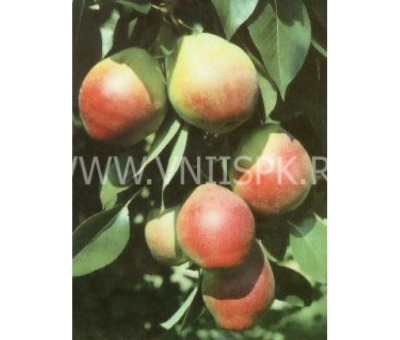
- Authors: S. T. Chizhov, S. P. Potapov (FSBEI HE RGAU Moscow Agricultural Academy named after K. A. Timiryazev)
- Appeared when crossing: Tyoma x Forest beauty
- Year of approval: 2000
- Fruit weight, g: 99-130
- Ripening terms: late autumn
- Appointment: technical
- Growth type: medium height
- Transportability: high
- Marketability: medium
- Crown: sprawling, funnel-shaped at a young age, in fruiting - rounded-oval, medium density
Previously, pears were grown exclusively in the southern regions, but today varieties have been bred that can grow productively in areas with a cool climate. One of these is the late autumn pear variety called Otradnenskaya.
Breeding history
Pear of Otradnenskaya is the creation of Russian breeders S.P. Potapov and S.T. Chizhov (Moscow Agricultural Academy named after K.A.Timiryazev). The result is a variety thanks to the crossing of two species - Forest Beauty and Tema. The fruit crop was entered into the State Register of Breeding Achievements in 2000. The variety is zoned in the Central Black Earth, East Siberian and North-West regions of the country. In addition, the pear is massively grown in the Moscow region.
Description of the variety
Otradnenskaya is a low-growing tree of the standard type, stretching up to 3-3.5 meters in height. A young tree is endowed with a funnel-shaped crown, which over time turns into a rounded oval. The trees have an increased thickening of dark green foliage, straight and curved shoots of brown color, conical dark brown buds and flowers, collected in a corymbose brush, 5-7 pieces each. During the flowering period (second half of May), the tree is covered with not very large snow-white flowers, pleasantly fragrant.
Fruit characteristics
Otradnenskaya pears belong to the group of medium-sized fruits. Fruit weight can range from 99 to 130 grams. The shape of the fruit is oblong-rounded with a noticeable ribbing of the surface. The ripe fruit is covered with a yellowish-green color, which is diluted with a blurry red blush. The peel of the fruit is of medium density, with dullness and noticeable subcutaneous punctures. There is no rusting on the skin of pears.
Pears are characterized by good transport tolerance and long shelf life - up to 100-120 days, subject to a temperature of zero degrees. The peculiarity lies in the following: the longer the fruits are stored, the higher their taste becomes. The purpose of the fruit is technical, more suitable for processing into jams, marmalades, mashed potatoes.
Taste qualities
The pear tastes good. The whitish-creamy pulp is of medium density, delicate texture with slight graininess, and sufficient juiciness. The taste is balanced - sweet and sour with a weak aroma.
Ripening and fruiting
The fruit belongs to the late autumn class. The tree bears fruit in the 3-4th year after planting. The fruit tree bears fruit regularly. You can taste the first pears in early September. The phase of active fruiting occurs in mid-September.

Yield
The pear tree yield is moderate.With proper care and favorable conditions, up to 40 kg of ripe pears can be removed from one tree during the fruiting period. On an industrial scale, the yield indicator is as follows: 195 centners of fruit per hectare.
Self-fertility and the need for pollinators
The Otradnenskaya pear tree is partially self-fertile. On a plot with this species, it is necessary to plant donor trees that bloom at the same time as the Otradnenskaya pear. The following varieties are considered the best pollinators for pears - Moskvichka, Marble, Nadyadnaya Efimova.
Landing
Planting is possible both in spring and autumn. In the spring, it is recommended to plant seedlings in late March - early April, when the soil and air are already warmed up. In the fall, planting a tree is carried out 3 weeks before the first frost, since it takes time for the adaptation of the root system and the tree as a whole. It is better to plant two-year-old seedlings with a developed root system.


Growing and care
The pear look is absolutely unpretentious to maintain, but the site and soil should be chosen carefully. The site must be cleared of weeds and other debris, and also be sufficiently illuminated by sunlight. A good soil for planting pear seedlings is loose, light, breathable, fertile and low acidity soil.
Comprehensive care of the fruit crop includes standard measures: watering, fertilizing, weeding of the peri-stem circle, protection from viruses and pests, whitewashing of trunks, as well as sanitary pruning of branches and crown formation. In regions with harsh winters, it is recommended to protect the tree from freezing by using trunk windings and mulching.



Disease and pest resistance
The variety is highly resistant to many of the common diseases that fruit trees are prone to, such as scab, powdery mildew and fruit rot. Spraying with insecticides will help protect the tree from invasions of moths, ticks and flower beetles.

Like any other fruit trees, the pear needs protection from various diseases and pests. When planting a pear on your site, you need to know in advance what diseases you should beware of. To successfully carry out the struggle, it is necessary first to correctly identify the cause of the problem. It is important to distinguish signs of disease from manifestations of the presence of insects, mites, caterpillars and other types of pests.
Resistance to soil and climatic conditions
Due to its high stress resistance, the tree easily tolerates extreme weather conditions, short drought and heat. In addition, the variety is winter hardy.





































































